1995 GMC SIERRA mirror
[x] Cancel search: mirrorPage 115 of 488
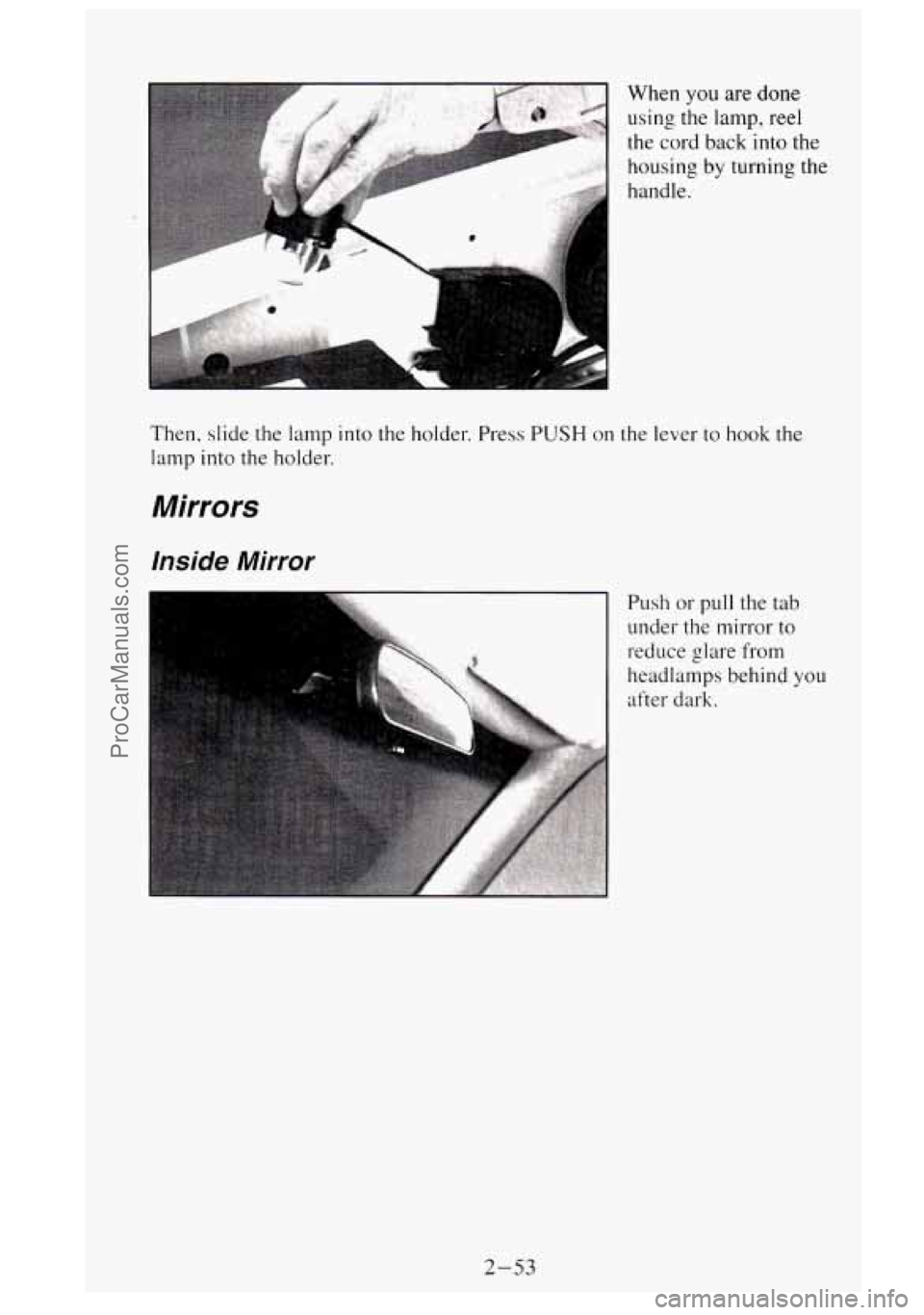
When you are done
using the
lamp, reel
the cord back into the
housing by turning the
handle.
Then, slide the lamp into the holder. Press PUSH on the lever to hook the
lamp
into the holder.
Mirrors
lnside Mirror
Push or pull the tab
under
the mirror to
reduce glare from
headlamps behind
you
after dark.
2-53
ProCarManuals.com
Page 116 of 488
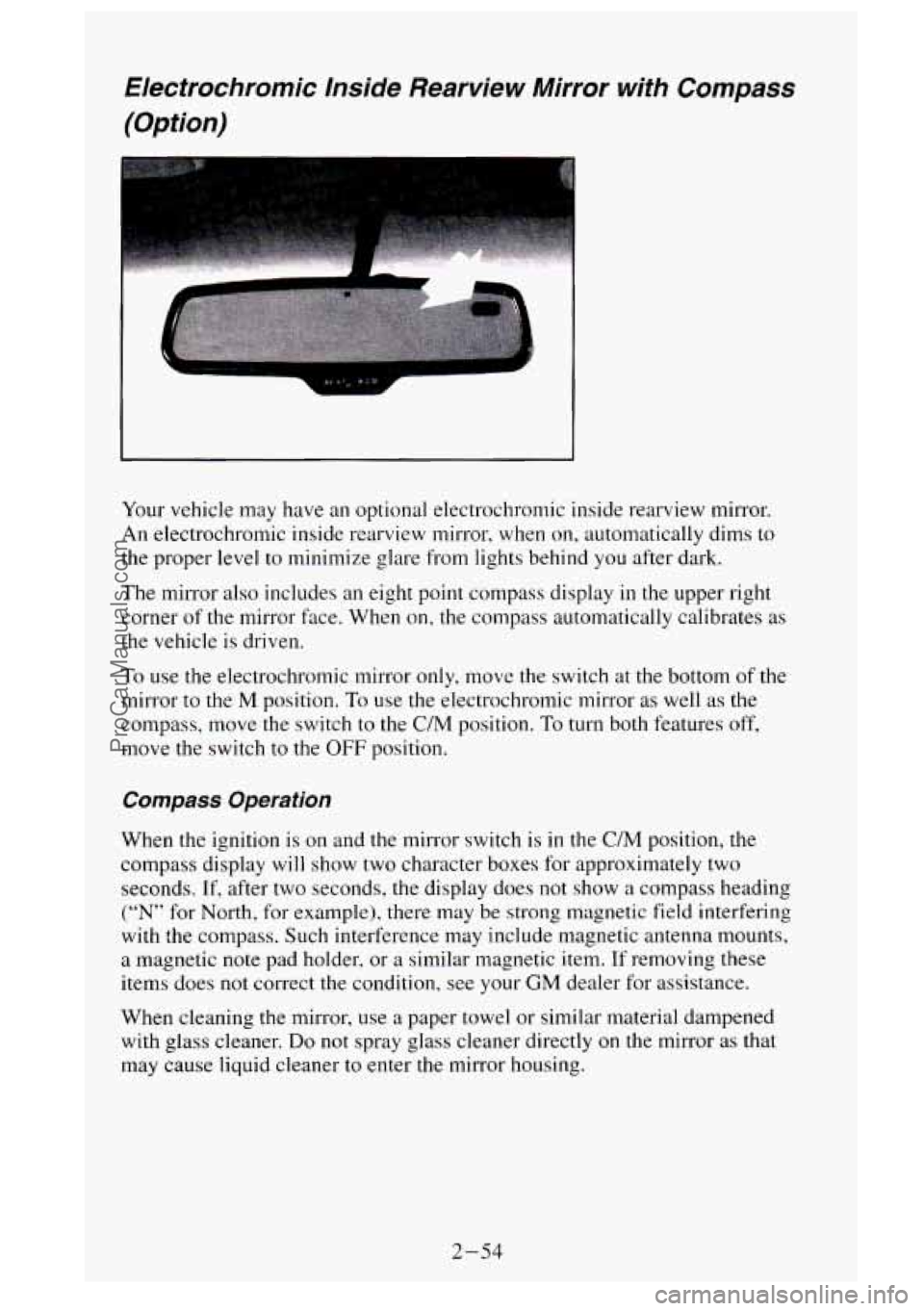
Electrochromic Inside Rearview Mirror with Compass (Option)
Your vehicle may have an optional electrochromic inside rearview mirror.
An electrochromic inside rearview mirror, when
on, automatically dims to
the proper level to minimize glare from lights behind you after dark.
The mirror also includes an eight point compass display in the upper right
corner
of the mirror face. When on, the compass automatically calibrates as
the vehicle is driven.
To use the electrochromic mirror only, move the switch at the bottom of the
mirror to the
M position. To use the electrochromic mirror as well as the
compass, move the switch to the
C/M position. To turn both features off,
move the switch to the OFF position.
Compass Operation
When the ignition is on and the mirror switch is in the C/M position, the
compass display
will show two character boxes for approximately two
seconds.
If, after two seconds, the display does not show a compass heading
(“N” for North, for example), there may be strong magnetic field interfering
with the compass. Such interference may include magnetic antenna mounts,
a magnetic note pad holder, or a similar magnetic item. If removing these
items does not correct the condition, see your
GM dealer for assistance.
When cleaning
the mirror, use a paper towel or similar material dampened
with glass cleaner.
Do not spray glass cleaner directly on the mirror as that
may cause liquid cleaner to enter the mirror housing.
2-54
ProCarManuals.com
Page 117 of 488
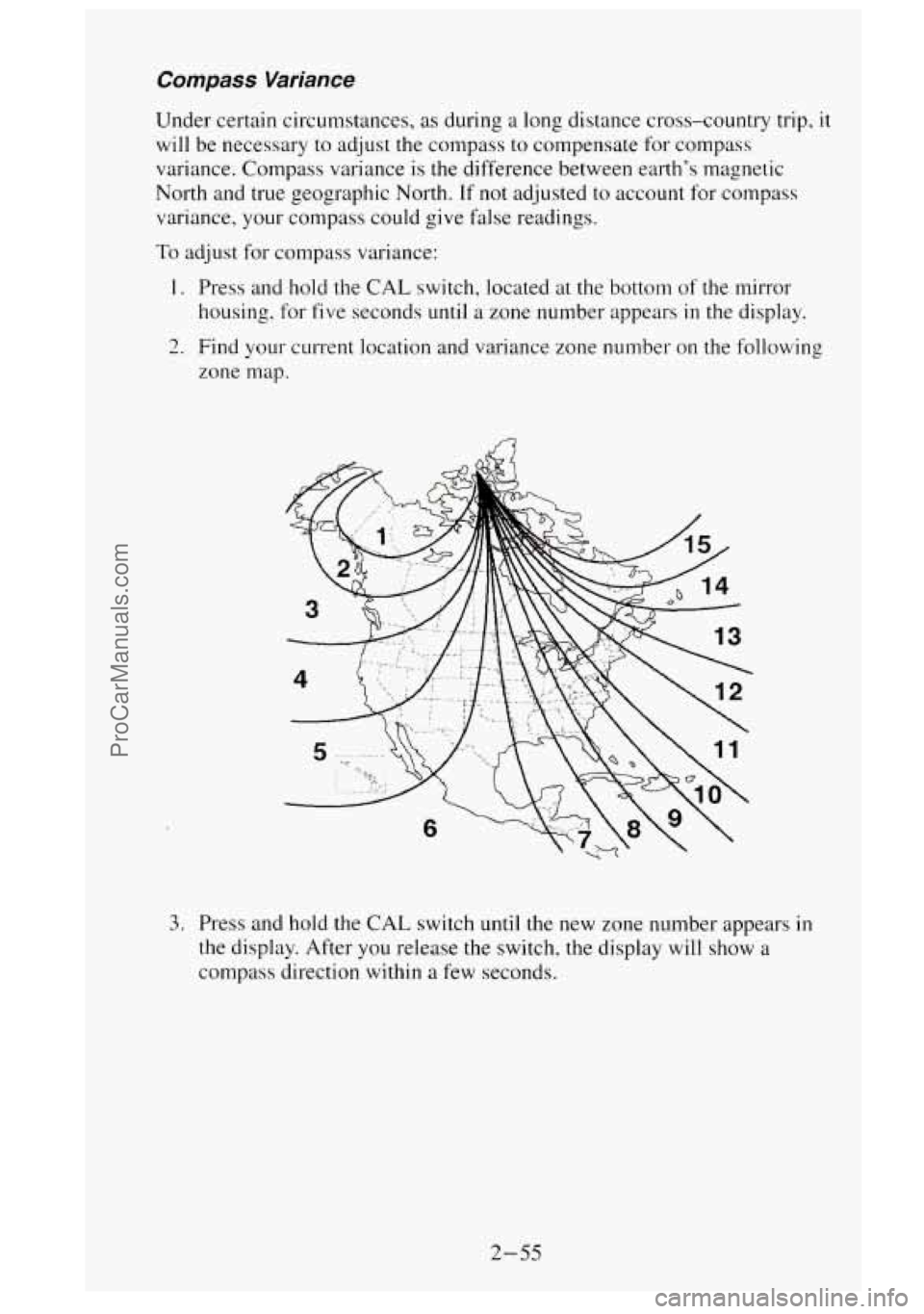
Compass Variance
Under certain circumstances, as during a long distance cross-country trip, it
will be necessary to adjust the compass to compensate for cornpass
variance. Compass variance is the difference between earth’s magnetic
North and true geographic North. If not adjusted to account for compass
variance, your compass could give false readings.
To adjust for compass variance:
1. Press and hold the CAL switch, located at the bottom of the mirror
housing, for five seconds
until a zone number appears in the display.
2. Find your current location and variance zone number on the following
zone map.
3. Press and hold the CAL switch until the new zone number appears in
the display. After you release the switch, the display will show a
compass direction within a few seconds.
2-55
ProCarManuals.com
Page 118 of 488
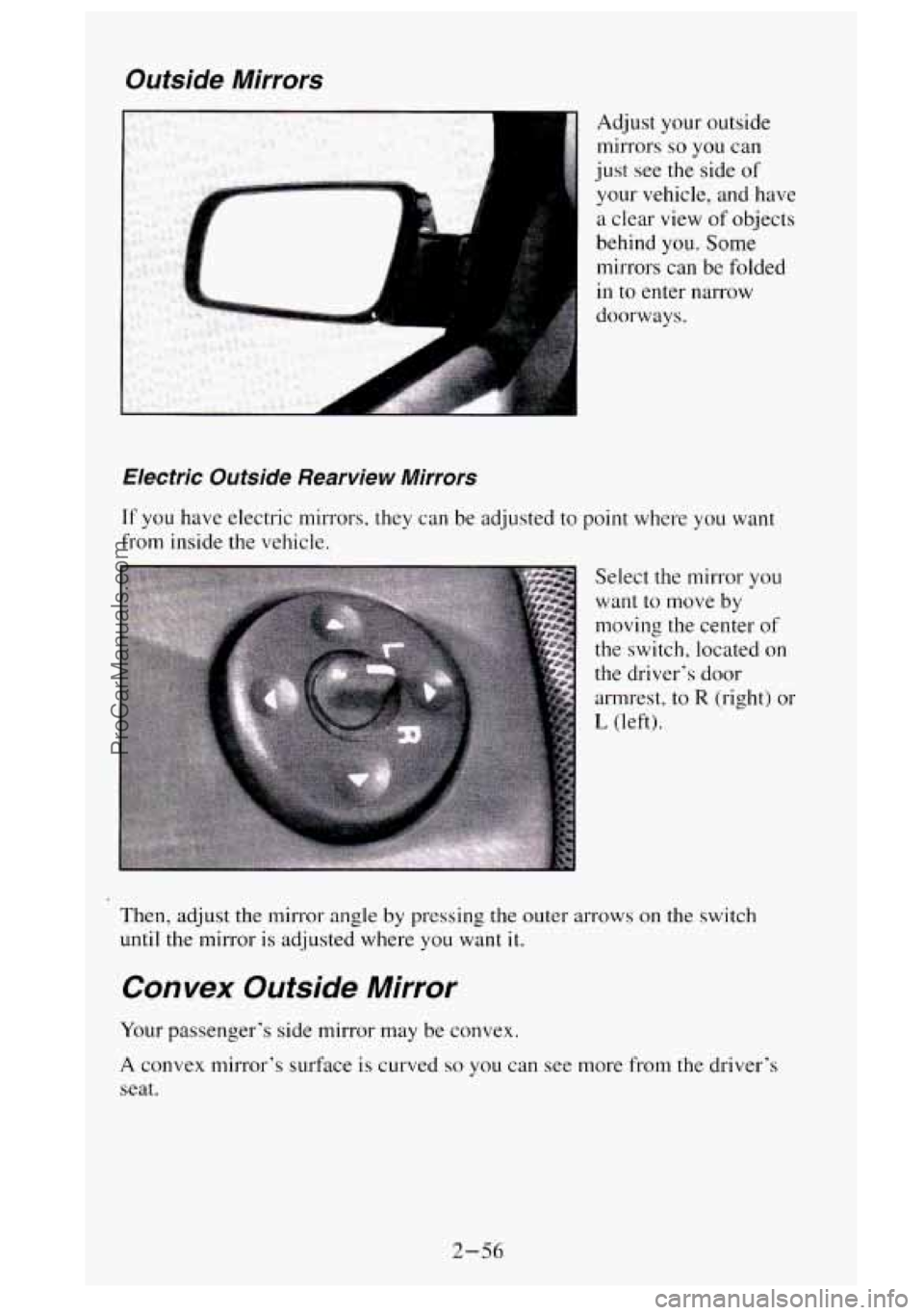
Ouiside Mirrors
F
Adjust your outside
mirrors
so you can
just see the side
of
your vehicle, and have
a clear view
of objects
behind
you. Some
mirrors can be folded
in to enter narrow
doorways.
Electric Outside Rearview Mirrors
If you have electric mirrors. they can be adjusted to point where you want
from inside the vehicle.
Select the mirror
you
want to move by
moving the center
of
the switch, located on
the driver’s door
armrest, to
R (right) or
L (left).
Then, adjust the mirror angle
by pressing the outer arrows on the switch
until the mirror is adjusted where you want
it.
Convex Outside Mirror
Your passenger’s side mirror may be convex.
A convex mirror’s surface is curved so you can see more from the driver’s
seat.
2-56
ProCarManuals.com
Page 119 of 488
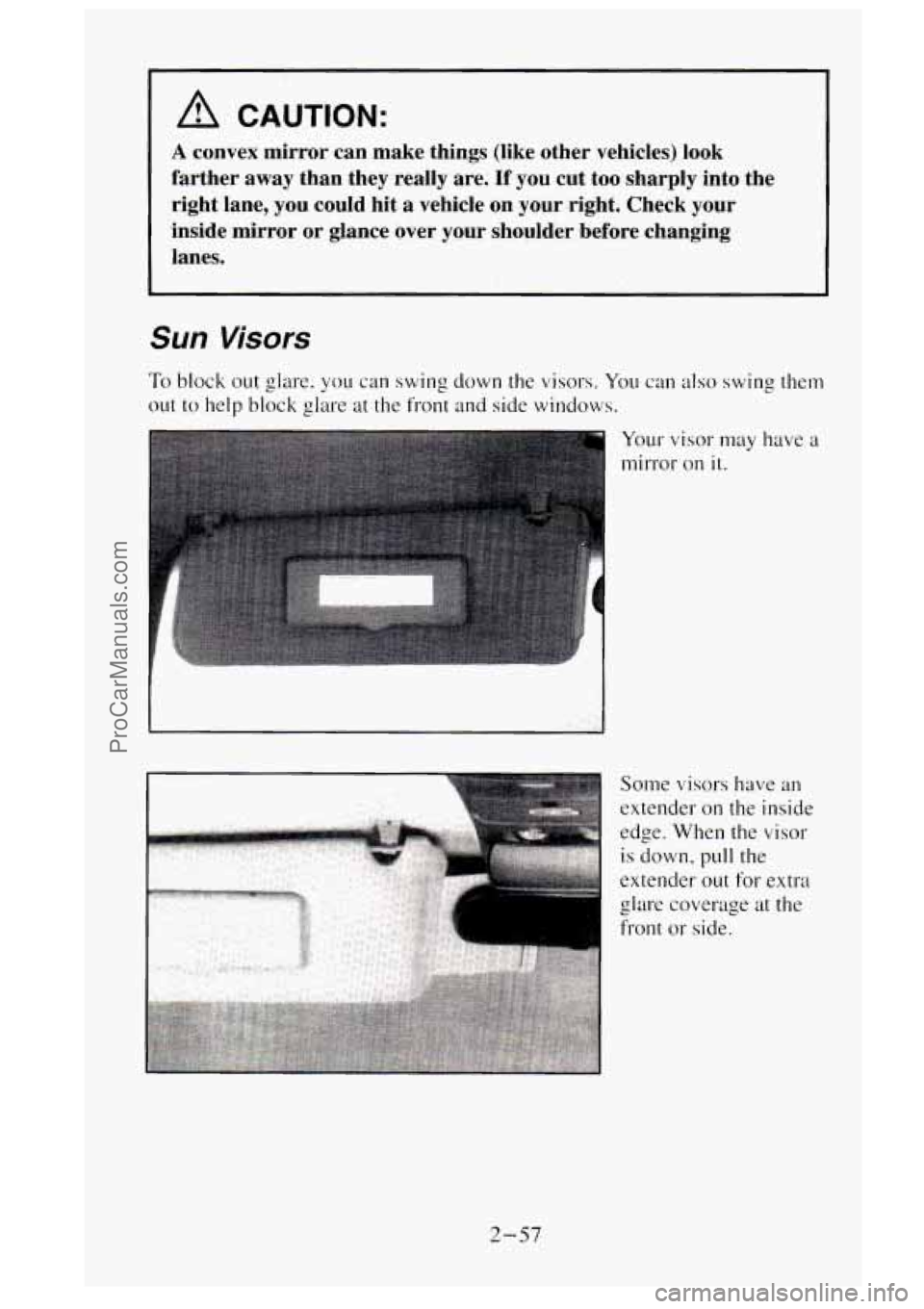
A CAUTION:
A convex mirror can make things (like other vehicles) look
farther away than they really are.
If you cut too sharply into the
right lane, you could hit a vehicle
on your right. Check your
inside mirror or glance over your shoulder before changing
lanes.
Sun Visors
To block out glare, you can swing down the visors. You can also swing them
out to help block glare at the front and side windows.
Your visor may have a
mirror on it.
2-57
ProCarManuals.com
Page 120 of 488
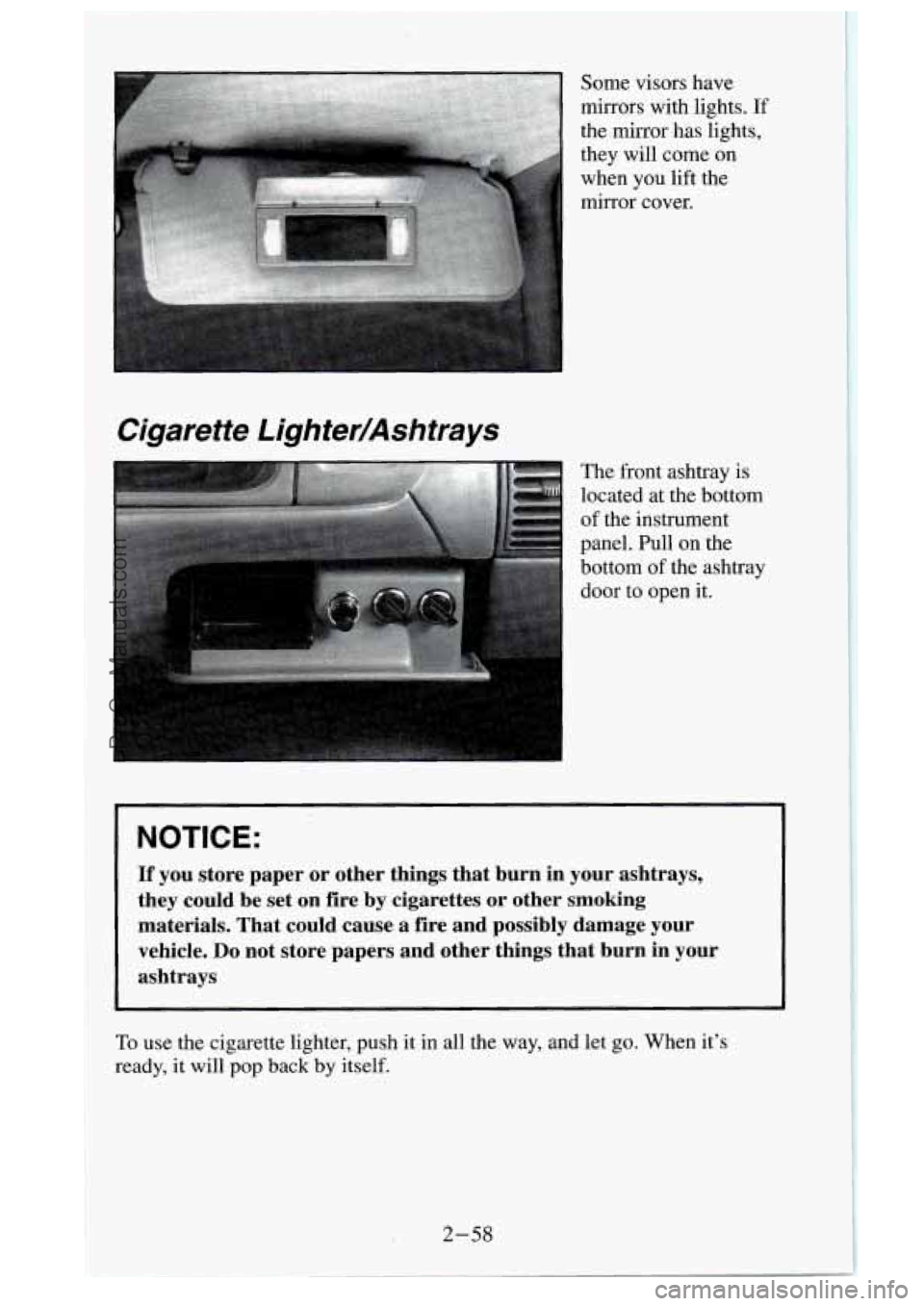
Cigarette Lighter/Ashtrays
The front ashtray is
located at the bottom
of the instrument
panel. Pull on the
bottom
of the ashtray
door to open it.
Some visors have
mirrors with
lights. If
the mirror has lights,
they will come on
when you lift the
mirror cover.
NOTICE:
If you store paper or other things that burn in your ashtrays,
they could be set on fire by cigarettes or other smoking
materials. That could cause a fire and possibly damage your vehicle.
Do not store papers and other things that burn in your
ashtrays
To use the cigarette lighter, push it in all the way, and let go. When it’s
ready,
it will pop back by itself.
2-58
ProCarManuals.com
Page 184 of 488
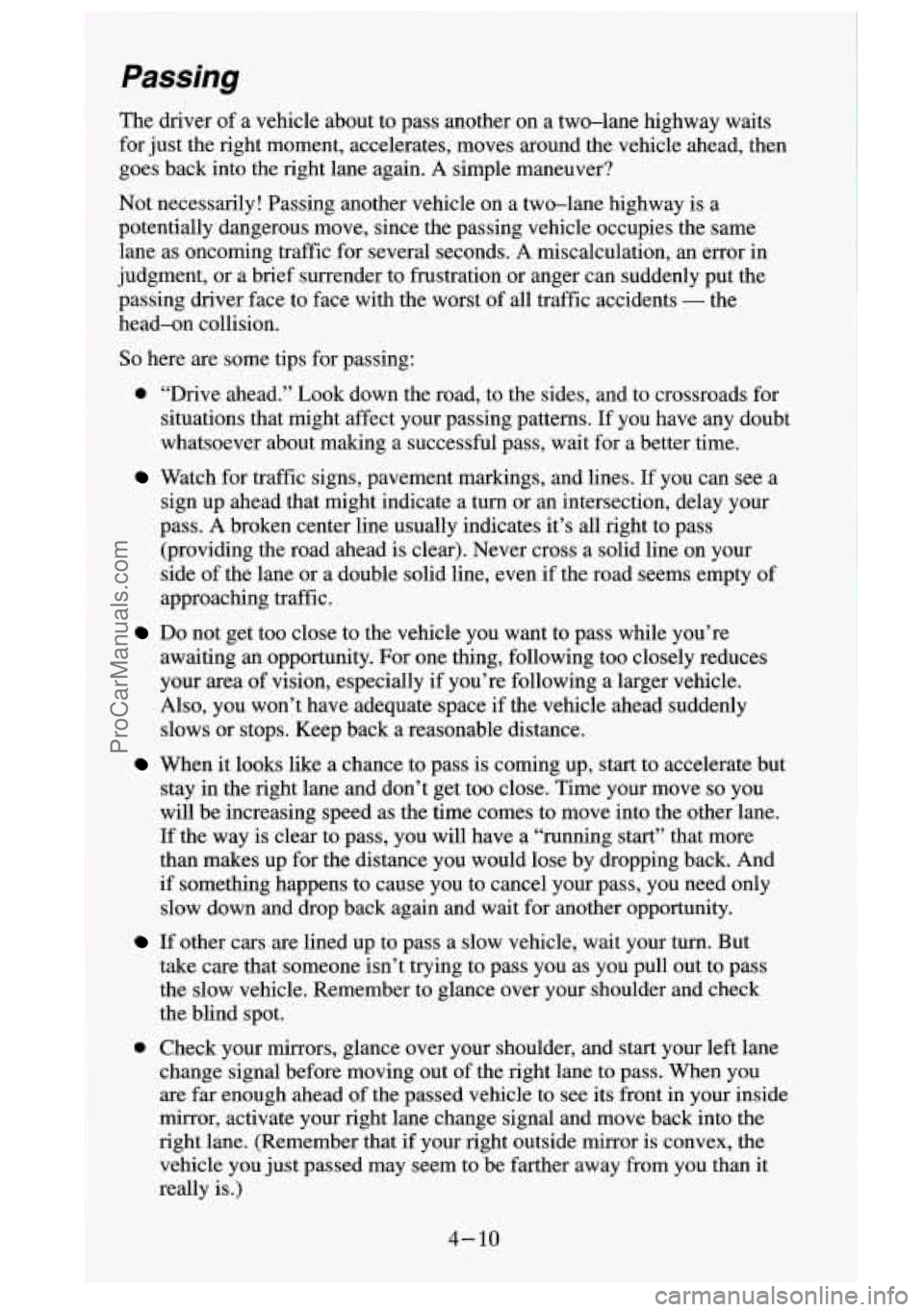
Passing
The driver of a vehicle about to pass another on a two-lane highway waits
for just the right moment, accelerates, moves around the vehicle ahead, \
then
goes back into the right lane again.
A simple maneuver?
Not necessarily! Passing another vehicle on a two-lane highway is a
potentially dangerous move, since the passing vehicle occupies t\
he same
lane as oncoming traffic for several seconds.
A miscalculation, an error in
judgment, or a brief surrender to frustration or anger can suddenly put the
passing driver face to face with the worst of all traffic accidents
- the
.head-on collision.
So here are some tips for passing:
0 “Drive ahead.” Look down the road, to the sides, and to \
crossroads for
situations that might affect your passing patterns. If you have any doubt
whatsoever about making a successful pass, wait for a better time.
Watch for traffic signs, pavement markings, and lines. If you can see a
sign up ahead that might indicate a turn or an intersection, delay your
pass.
A broken center line usually indicates it’s all right to pass
(providing the road ahead is clear). Never cross a solid line on your
side of the lane or a double solid line, even if the road seems empty of
approaching traffic.
awaiting
an opportunity. For one thing, following too closely reduces
your area of vision, especially if you’re following a larger vehicle.
Also, you won’t have adequate space if the vehicle ahead suddenly
slows
or stops. Keep back a reasonable distance.
When it looks like a chance to pass is coming up, start to accelerate but
stay in the right lane and don’t get too close. Time your move
so you
will be increasing speed as the time comes to move into the other lane.
If the way is clear to pass, you will have a “running start” that more
than makes up for the distance you would lose by dropping back. And
if something happens to cause you to cancel your pass, you need only
slow down and drop back again and wait for another opportunity.
If other cars are lined up to pass a slow vehicle, wait your turn. But
take care that someone isn’t trying to pass you as you pull out to pass
the slow vehicle. Remember to glance over your shoulder and check
the blind spot.
0 Check your mirrors, glance over your shoulder, and start your left lane
change signal before moving out of the right lane to pass. When you
are far enough ahead of the passed vehicle to see its front in your inside
mirror, activate your right lane change signal and move back into the
right lane. (Remember that if your right outside mirror is convex, the
vehicle you just passed may seem to be farther away from you than it
really is.)
Do not get too close to the vehicle you want to pass while you’re
4- 10
ProCarManuals.com
Page 185 of 488
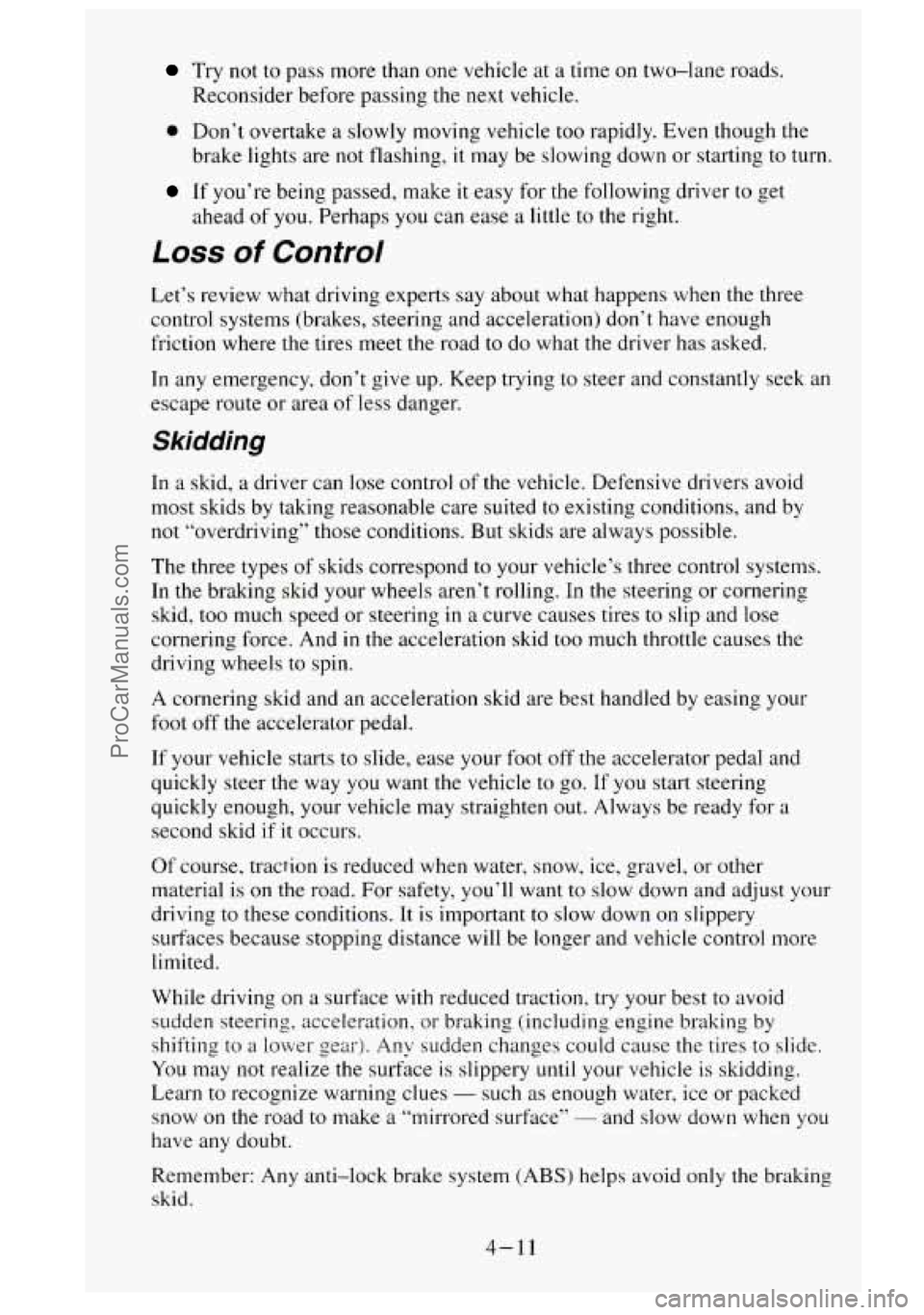
Try not to pass more than one vehicle at a time on two-lane roads.
Reconsider before passing the next vehicle.
0 Don’t overtake a slowly moving vehicle too rapidly. Even though the
brake lights are
not flashing, it may be slowing down or starting to turn.
If you’re being passed, make it easy for the following driver to get
ahead
of you. Perhaps you can ease a little to the right.
Loss of Control
Let’s review what driving experts say about what happens when the three
control systems (brakes, steering and acceleration) don’t have enough
friction where the tires meet the road
to do what the driver has asked.
In any emergency, don’t give up. Keep trying
to steer and constantly seek an
escape route or area of less danger.
Skidding
In a skid, a driver can lose control of the vehicle. Defensive drivers avoid
most skids by taking reasonable care suited
to existing conditions, and by
not “overdriving” those conditions. But skids are always possible.
The three types of skids correspond to your vehicle’s three control systems.
In the braking skid your wheels aren’t rolling. In the steering or cornering
skid, too much speed or steering in
a curve causes tires to slip and lose
cornering force. And
in the acceleration skid too much throttle causes the
driving wheels to spin.
A cornering skid and an acceleration skid are best handled by easing your
foot off the accelerator pedal.
If your vehicle starts to slide, ease your foot
off the accelerator pedal and
quickly steer the way you want the vehicle
to go. If you start steering
quickly enough, your vehicle may straighten out. Always be ready for
a
second skid if it occurs.
Of course, traction is reduced when water, snow, ice, gravel, or other
material is on
the road. For safety, you’ll want to slow down and adjust your
driving to these conditions. It is important to slow down on slippery
surfaces because stopping distance will be longer and vehicle control more
limited.
While driving on a surface
with reduced traction, try your best to avoid
sudden steering, acceleration. or braking (including engine braking
by
shifting to a lower gear). Any sudden changes could cause the tires to slide.
You may not realize the surface is slippery until your vehicle
is skidding.
Learn
to recognize warning clues - such as enough water, ice or packed
snow
on the road to make a “mirrored surface” - and slow down when you
have any doubt.
Remember:
Any anti-lock brake system (ABS) helps avoid only the braking
skid.
4-13
ProCarManuals.com